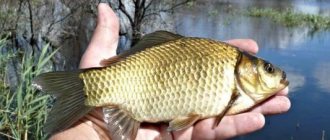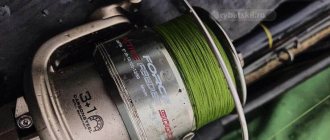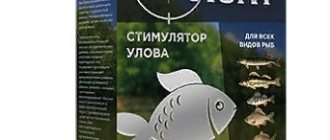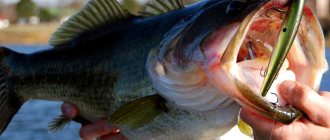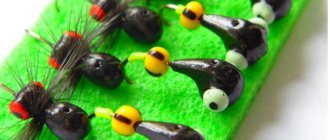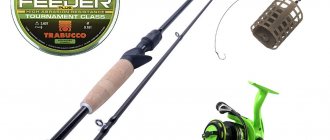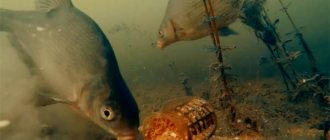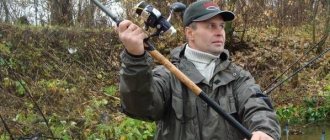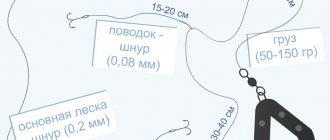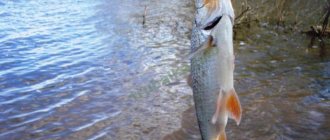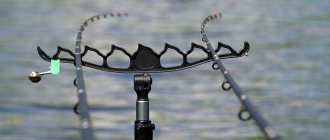How to find a fishing spot
When choosing the right place, you need to start by looking for a deep edge. This is done using a marker weight. It is thrown to a distant point and slowly pulled towards the shore, examining different areas on the bottom.
When the weight hits any obstacle, the line will signal its rise.
This will be the edge into which you need to throw more feeders with complementary foods. But before that, you should make sure that the load does not rest against a stone or the remains of a tree. Therefore, it is worth performing a few more test casts of the sinker.
Catching ide on a feeder in the current
At different times of the year, prey can live not only at great depths, but also near the shore. When small insects appear, the fish rises to the very surface, where it guards its food, so you should catch it in the current near trees or overhanging bushes.
After the onset of cold weather, it moves closer to the bottom.
In autumn, it is better to catch ide in the middle of the riverbed.
Fishing in ponds or lakes
Ide lives in ponds and lakes that have a lot of oxygen. In other words, the water must be running. It can be found in clayey and silty areas, as well as where there are many pools or deep holes.
The most popular place for fishing for prey is considered to be the lower edges .
This is a break in the topography of the river bottom, located near the shore, in which a sharp increase in depth is observed. It is in such places that the predator should be caught in ponds and lakes.
Description of the fishing object
The ide is a fairly large fish of the Karpov family. Its dimensions on average range from 30 to 50 cm, and its weight can be from 2 to 3 kg. Occasionally there are real giants, up to a meter long, weighing about 6 kg.
The ide diet is quite varied: it feeds on both plant and animal foods. Young individuals prefer algae, larvae of small insects, and small crustaceans. Middle-aged fish gradually switch to worms and mollusks. Adult specimens of ide are not averse to eating small frogs and large insects.
Ide is distributed almost everywhere in Europe. It can live in both fresh and brackish water. It doesn’t really like fast currents and cold water, so ide can often be found in bodies of water with slow currents and moderate depth.
Ide is also found in ponds or lakes, if they have enough oxygen, that is, they are flowing. You can find fish in silty and clayey areas; She often gives preference to places where there are holes or pools. You can also find ide near bridges.
One of the main places for catching ide is the lower edge - a break in the bottom topography in relative proximity to the shore, where a sharp decrease in depth occurs. Most often, ide likes to feed on the edge. These are the places that are most preferable to catch ide in the off-season.
Features of seasonal fishing for ide
The best time for fishing for ide is mid-May, when the fish finish spawning and begin to actively feed to replenish their energy reserves.
Baits
The best baits for catching ide on a feeder are:
- black bread;
- moths;
- grasshoppers.
While the fish has not yet grown, its diet consists of small insects, algae and crustaceans. Then she begins to feed on worms and leeches. When the ide fully matures, it begins to eat fry, tadpoles and large insects.
Spring
The predator begins to spawn very early - its activity increases after the water warms up to 7 degrees. This happens at the very end of March or beginning of April.
After the end of spring spawning, the ide undergoes a period of rest for several weeks, when it practically does not move, and only in May does the feeding begin.
Catching hungry ide in the spring with a feeder is best done on deep edges or in shallows. In some lakes, fish activity manifests itself in dense thickets of algae. After the insects appear, the predator gradually moves closer to the shore.
Summer
In summer, when many insects fly over the water, the predator feeds in shallow water. During this period, you should look for it near trees or large bushes growing near water bodies. He also often hides in thick algae or snags. The best bite during this period is observed in the early morning hours.
Closer to September, the fish begin to neglect caution and are often caught near the surface of the water.
This is observed not only near the shore, but also in the middle of the river. After mid-July, the activity of ide increases daily, and it becomes omnivorous. Young predators grow up and begin to hunt for small fish.
Autumn
If the water is still warm in September, then the autumn behavior of the predator is almost no different from the summer. It feeds near the shore and in the upper layers of lakes, where it looks for large insects. To catch ide on a feeder in the fall, it is recommended to use grasshoppers, flies and gadflies as bait.
After the onset of cold weather, the fish again return to bottom feeding. Individuals gather in schools and almost constantly rest in deep holes, hunting on their boundaries. For this reason, in such areas it is necessary to feed ide using plant substances. You don’t have to add flavorings to the bait, because the prey will still swim to the casting sites. At this time, fishing with a feeder brings maximum results.
Where should you look for ide in the spring?
With the arrival of spring, ide sites can be found in shallow water areas, with an underwater current and a rocky bottom. The route of movement of the ide is quite easy to calculate, especially in small rivers. The best bites, as a rule, occur in coastal places with a calm and quiet current, at a depth of about 1.5 m, where tree branches or other vegetation hang over the water.
You can catch ide in the spring on a feeder throughout the day. The best results are shown by fishing in the early morning, which lasts until 10 am. In the afternoon, the fish bite becomes active again. The next peak of the bite begins in the evening and lasts until full twilight. The ide is also ready to amuse lovers of night fishing, as it usually does not sleep at night and is wonderfully caught with feeder gear.
Lures for catching ide
The feeder should be completely covered with complementary foods. It is necessary to make sure that it is not visible at all, because after hitting the bottom, particles of the mixture will immediately begin to separate and attract prey. After a long cast, a cloudy cloud should form in the water, which consists of dissolved bait washed away by the current.
The main components of complementary food for fish are:
- oatmeal;
- boiled peas;
- breadcrumbs;
- steamed millet;
- maggots;
- dough;
- canned corn.
As bait, you can use mayfly mixed with clay, or special store-bought mixtures that combine plant and animal ingredients. Such compositions have a strong aroma that attracts predators. But many fishermen advise mixing it with boiled wheat porridge.
River seasonal picky
Ide lives his life, which is purely destined for him by nature. He does not like winter cold and sudden changes in weather. He doesn't like the soft muddy bottom and the fast, smooth current. He is an exceptional vegetarian, but is not averse to trying some animal dessert (bloodworms, worms, maggots and insects). Having felt strength with age, he enjoys enjoying the fruits of the predatory hunt, exploring the shallows along the water’s edge at night.
Gathering in flocks, it constantly lives in pools behind rifts, uneven spots and holes behind bridge piers, in coastal snags under overhanging bushes. With the change of seasons, ide also changes its preferences and habits. With the onset of October cold and bad weather, it loses activity and practically does not feed until the first melt water. Fishing for ide on a feeder is possible only in open water.
Spring fishing for yaz on a feeder
As soon as the first melt water, enriched with oxygen, enters the reservoir where the ide lives, it begins to emerge from its stupor and make timid attempts in search of food. By the time of the flood, he already begins to look for exits to flowing streams and rivulets. During a flood, it becomes the sovereign owner of flooded meadows, oxbow lakes and ravines. Climbing along the beds of small rivers and spring flood streams, the ide actively feeds and feels great.
Once a fisherman finds himself on such a river, he will remember for a long time that catching ide in the spring on a feeder is a fantastic reality. By throwing the feeder to the opposite bank, you can be absolutely sure of the immediate subsequent bite on bloodworms, worms, maggots, or a sandwich made of them. Any store-bought bait mixture will be in full demand.
On large rivers and reservoirs, fishing for ide in early spring is somewhat different. Seasoned specimens do not leave their holes, pools and deep gullies for a long time. This is where you should look for trophy ide, after feeding the fishing spot for several days. Steamed peas, wheat and corn must be present in feeding mixtures. You will have to fish with both plant and animal baits. They should also be present in the feeder feeder.
Summer equinox and ide activity
In the second half of the spring splendor, the ide prepares for spawning. It actively feeds and gradually moves back to its summer habitat. Fishing on a feeder becomes much more difficult, including due to the flight of cockchafers and other insects. The fishing ban is still in effect. The ide continues to explore the water area it likes in large flocks. The rivers are entering their channels and already in June we can talk about the beginning of the summer fishing of ide on the feeder.
Photo 3. The river returned to its channel.
By mid-June you can already go fishing for ide on the feeder, using the same fishing spots. In these places, located along the edges of pits near rifts, under bank cliffs and steep banks, they begin to fish without preliminary feeding. A few large feeders with bait before starting fishing will be enough. In the future, you should work with small-sized models.
In new places formed by floods, with promising bottom topography, it is better to pre-feed with several balls. It will be easier for fish to find a fed area of the bottom than a tangerine-sized feeder. Although it should be noted that in terms of the number of aromatic additives, feeder mixtures are leaders.
After the first bites, you can move on to feeder fishing for ide and other fish. As bait - the usual feeder mixtures. They differ from ordinary mixtures in that when moistened they compact differently in the feeder. This means that the rate of erosion of the bait also changes.
As bait, use the usual assortment of plant and animal species for ide. Gradually, steamed peas and wheat become the leaders among baits. But at the same time, the number of bites from other fish is significantly reduced. In this case, the choice remains with the fisherman, because all the inhabitants of the reservoir will approach the feeder.
Autumn enthusiasm of ide before winter torpor
By the end of October - beginning of November, the ide loses activity and gradually slides down the river into wintering pits. He only occasionally, on warm, fine days, goes out onto the sun-warmed shallows near holes and cliffs to hunt for fry and rare insects. But before that, he had already had plenty of fun in the flocks, periodically forming real cauldrons. It is before the winter torpor that autumn ide fishing can be the most productive.
Unlike summer fishing, due to the significant clearing of the water, it is necessary to use the most delicate tackle. At the same time, fluorocarbon leashes will allow you to avoid annoying breaks when fishing for large specimens. The bait should be the most fragrant at this time. A feeder mixture using biscuit flour and animal additives may be justified. The bait will still have to be selected from the ide’s favorite assortment, depending on the fishing conditions. He had been a picky eater since spring, and by fall he remained so.
In open water, you can catch ides with a feeder until the freeze-up, but every day it will become more and more difficult. Perch and roach fill all previously fed and promising places. Plant attachments most often end up unclaimed. Only fishing in pre-fed areas and with very thin tackle will allow the fisherman to enjoy all the delights of autumn fishing. But ide may no longer be in the bycatch.
Feeder equipment for ide
Even a novice angler can rig a feeder rod. The main requirement is that the rod must be extremely sensitive so that every slight touch of the trophy to the bait is immediately reflected on the tip.
How to wind fishing line
The length of the main line should be between 50-100 m. It can be not only monofilament, but also a braided cord with a diameter of 0.18-0.25 mm. First, a reel with a spool size of 2000-2500 units is installed on the fishing rod, and then the monofilament is passed through all the rings from the top of the rod to the device itself. The fishing line is attached to the spool using a strong knot.
The line handler arm then returns to its normal position.
By slowly rotating the reel handle, the fisherman winds the line onto the spool. It needs to be filled with monofilament almost to the brim, leaving 2 mm free up to the side. After this, during long casts it will drop smoothly.
Gear configuration
To catch the cunning and stubborn ide you need very strong tackle. And if we take into account the distrust and caution of prey, then you need to be able to throw the bait over a considerable distance.
You can attract a predator only with a large amount of complementary food, so you should choose a spacious feeder for the feeder.
When choosing it, the fishing location is of great importance. If fishing will take place on a river with a strong current, then the device should be as stable as possible and have a heavy bottom. Compliance with such conditions will prevent the water flow from carrying away the complementary food from the desired place.
Read what feeders should be like for flow on the feeder.
Since fishing in the spring with a feeder is carried out in coastal areas at shallow depths, a suitable option would be to use monofilament with a breaking load of no more than 3 kg. This monofilament will allow you to make long casts and get decent trophies.
Equipment
Catching predatory ide on a feeder is carried out using various equipment that allows you to securely fix the feeder. Many fishermen use a special anti-twist tube or a convenient paternoster. A thin tube should be put on the monofilament and the feeder mount should be attached to it through a swivel. The anti-twist is limited on the fishing line by silicone stoppers. A Gardner loop is considered a good rig option.
With this method, a leash with a hook is tied through a swivel using the loop-to-loop method. The length of the leash should be between 25-75 cm. Many anglers make it much longer, which has a positive effect on the amount of catch.
Fishing technique
Usually, if the feeding goes well and the bait is chosen correctly, catching ide is quite simple. Small specimens take the hook literally right away. Larger specimens can walk around the bait for quite a long time without trying to swallow it.
The following components can be used as a nozzle:
- steamed pearl barley porridge;
- steamed wheat;
- dung worm;
- caddisfly.
As an additional component of the nozzle, maggot will never be superfluous. It will fit any of the listed attachments.
The bite is accompanied by a slight pull; in rare cases, there will be several twitches. Then comes a sharp and strong grip. Usually, the ide, having taken the bait, begins to sharply move upstream. In some cases, this leads to sagging fishing line. At this moment a sharp cutting should be made.
The ide on the hook begins to behave extremely violently. You shouldn’t be too persistent in trying to “pull” the fish by force. This may lead to the gear breaking.
It is necessary to lead the fish for some time so that it gets tired, gradually landing it in shallow water, preferably against the current. Considering the relatively large size of the ide, the presence of a landing net is mandatory, and its length must be no less than the length of the fishing rod.
Some nuances of catching ide on a feeder can be seen in this video:
Success in catching ide on a feeder is due to the combination of all factors influencing fishing. Tackle and bait should be chosen taking into account the season, but if everything is done correctly and the fishing spot is baited, you won’t have to wait long for an ide bite. The main thing is to be patient and not to forget the basic rules of fishing - from proper bait and camouflage to the peculiarities of fishing.
Fishing process
When fishing, it is advisable to use a comfortable chair. Modern devices allow you to attach a small table and a fishing rod mount to them. You can lay out various baits or complementary foods on them. As an alternative, a simple folding chair will do.
How to install a fishing rod on a stand
There are vertical and horizontal methods for installing a feeder fishing rod. The first method is more often used in reservoirs with fast water movement.
With this choice of installation, a significant part of the thin fishing line will be above the water and will not be able to sail due to the strong current.
Horizontal installation is more suitable in strong winds, since most of the monofilament will be under water and will not be affected by air currents. The line needs to be tensioned so that the tip of the fishing rod is slightly bent.
How to cast a feeder
When assembling the fishing rod, you need to check that the rings are exactly in a row. If they are installed differently, this will greatly affect the smoothness of the monofilament, as well as the accuracy and casting distance. Before throwing the feeder, the sinker or feeder should be pulled 1 m to the tip.
To prevent the line handler from closing, before casting it must be brought back and set parallel to the horizon.
The rod is held with the right hand near the reel mount. Using your index finger, the line is pressed against the rod blank. The end of the handle is grasped with the left hand and then cast. You need to make sure that the monofilament does not get tangled, because this can break the tip. The line is released when the rod is in the most vertical position.
How to detect a bite
The tip of the fishing rod or quivertip is also a feeder bite indicator. When an ide touches the bait, it bends and jerks violently. But it should be remembered that the tip can move due to gusts of wind or changes in the flow of the river.
Trembling and jerky movements of the quiver tip indicate a bite, and slow and barely noticeable swaying often turns out to be false.
This predator makes a sharp and short-term jerk, so it is necessary to carefully observe changes in the inclination of the tip. When the ide swallows the bait, the line will immediately sag.
How to hook
To properly hook the prey, you need to remove the fishing rod from the stand and move the tip 0.5 m to the side with a relatively quick, but not sharp movement. When hooking a predator, you cannot overdo it, because you can tear its lips and miss the trophy.
How to fish
When playing, the fish makes sharp jerks, for which you need to prepare in advance. You should carefully adjust the friction mechanism of the reel in order to loosen the line in time when it becomes too tight.
When fishing, you need to periodically lift the fishing rod and reel in the monofilament.
To prevent the leader from breaking or the equipment from breaking, a landing net should be used. The hook should be removed from the mouth of the ide using a special extractor.
Features of feeder fishing
Attention must be paid to such an important process as feeding, which in the case of ide has its own specifics. The main problem is that it reacts to the offered food in a unique way, much more passively than bream or roach. It is still possible to attract him somehow, but not all fishermen manage to keep him on the spot. And all because, by and large, there is nothing to keep, because ides do not gather in numerous schools, like the mentioned “feeder” fish. They move around the reservoir in modest groups of several heads (sometimes up to ten).
To attract a handsome fish, the bait must contain finely dispersed components that create a lot of turbidity. When catching ide with a feeder in the current, dry, powdered clay copes with this task perfectly. In addition, it significantly increases the viscosity of the mixture, which is also welcome in feeder ulcer fishing. Large fractions should also be included (approximately 15-20%). The basis of the bait is usually a ready-made base mixture from the store or breading.
At the beginning of the season, the effectiveness of feeding ide is relatively low. He is more attracted to the cloudy plume rather than food particles. From mid-summer it increases significantly, which is confirmed by the presence of food components in the intestines of caught specimens.
Catching ide on a feeder has another feature. The bait attracts numerous schools of other species (bream, roach, silver bream and even chub), so it often ends up as just a bycatch. But for the sake of its powerful bite and the resistance it provides, you can be patient.
By the way, about the bite. The ide bites sharply and confidently, hard enough to pull the rod off the stand. When you feel a hook in your mouth, it begins to fight for life and shows all its strength, so it is important to set the clutch correctly.
⚓ Fishing
At the final stage of fishing, a lot depends on the skill of the fisherman. When only a few meters remain from the shore, the ide increases resistance and can unexpectedly and sharply jerk to the side. Often such a maneuver restores his freedom. At the same time, the depreciation of the line over a short distance is almost zero, the main load falls on the reel clutch and the rod. The angles of the latter are so critical that you wonder how it can withstand it all. That is why successful catching of ide on a feeder is impossible without a landing net, the length of which should not be much less than the feeder form. For example, if you are using a 4-meter fishing rod, then the best option would be a landing net with a handle of 3.5-3.7 meters. It is advisable that it be carbon or made of some other lightweight material, otherwise the angler’s hand will experience serious stress.
Description and behavior characteristics
Ide belongs to the carp family. It is particularly undemanding to either the chemical composition of water or temperature fluctuations. Its scales are small, have a metallic sheen with a golden tint, the body is slightly elongated, the head is convex and small, all fins are reddish in color and have a notched shape.
In young males the scales are painted in brighter colors, while in females they are duller. Sexual maturity occurs at 4–5 years, but much will depend on the characteristics of the reservoir and food supply. It spawns very early, when the water temperature rises to only 5–8.
Their average weight reaches 2 kg, but you can also find 8-kilogram ides. It can eat many things; it is practically omnivorous: plant foods, earthworms, mollusks, crustaceans, small fish, larvae of various insects, etc. It is a schooling fish and can travel considerable distances for wintering migrations and spawning.
Likes to be on the border between calm water and fast current. Never goes to sandbanks, rifts, or open areas. Spends almost all of its time in shelters, leaving them only in search of food.
Its behavior is reminiscent of predators: catfish, pike, etc. If it lies on the bottom, neither a small fish swimming nearby nor an insect seductively falling into the water will be able to lure it out.
Float rod
The ide is caught using float tackle in rivers and flowing reservoirs throughout the open water season. To do this, use gear consisting of a 5-meter Bolognese carbon-fiber fishing rod, a small spinning reel measuring 300-500, and a supply of monofilament fishing line with a cross-section of 0.18-0.22 mm. The equipment of a float fishing rod for ide consists of a spindle-shaped float with a load of 5-6 g, a small leash made of monofilament fishing line with a cross-section of 0.12-0.14 mm.
When choosing a place and bait for float fishing for ide, take into account the water temperature and time of year: • in early spring, ide is caught in areas of the reservoir that are well-warmed by the sun, with shallow depths and weak currents. In summer and autumn, ide prefers to stay in deep areas most of the time. • in spring and autumn, fish bite better on various baits, in mid-summer - on vegetable baits, as well as “sandwiches” (canned corn + worm, barley + bloodworm, bloodworm + maggot).
Recipes for ide
The bait can consist exclusively of dry components, to which water is added already on the pond. This method is good in hot weather, since ready-made porridges from peas and cereals quickly turn sour, and the dry mixture can be kneaded as needed.
Recipe No. 1
This bait for catching ide consists of the following components:
- Dry feed – 2 kg
- Corn grits or corn – 1 kg
- Makuha – 1 kg
- Breadcrumbs – 1 kg
- Semolina – 1 kg
- Wheat bran – 1 kg
- Cookies – 2 kg
- Hercules – 0.5 kg
- Ready-made mixture for carp – 1 kg
- Cocoa – 100 g
- Ground coriander – 50 g
The dry mixture, prepared in advance with your own hands, is mixed with well-steamed peas on the shore.
Recipe No. 2
The basis of this option is millet porridge. To prepare it you need:
- 1 cup millet;
- 3 glasses of water.
For flavor, add corn flour or crushed roasted sunflower seeds to the porridge. Crushed Hematogen, which is sold at the pharmacy, is also added here.
Recipe No. 3
The most primitive way is to prepare bait from what you found in the pond. If you have makha with you, you also need to add it to the mixture. The following components will be required:
- Clay from a pond
- Grass
- Mayfly larvae
- Machuka or sunflower seeds
This composition is used if there is nothing else, that is, you did not specifically prepare to catch ide, but the place is clearly where it lives.
Feeder fishing: equipment, baits and fishing techniques
We fish on the feeder. The feeder is an improved and modified bottom fishing rod. However, fishing with a feeder is a more convenient and practical method compared to its predecessor. If a person is truly interested in fishing and considers it his hobby, then he must sooner or later master the feeder. After all, this is not just a modern fancy fishing rod that you can show off to your fishing partners, but a truly useful and convenient thing in a fisherman’s arsenal.
You can fish with this tackle in almost any body of water. It is unlikely that there will be one where there will not be a single bottom fish. The only thing a novice angler needs to consider at this point is what bait to choose.
Feeders differ from each other not only in the length of the rod, but also in the action, as well as in the test. The feeder test determines its strength and sensitivity when casting, which can be determined by two numbers, for example, a spinning test of 50 - 180 grams. This means that the spinning rod is designed for casting any feeders weighing from 50 to 180 grams. The lower limit of 50 grams means that a feeder lighter than 50 grams will not be felt when casting and you will not be able to cast far. The upper limit of 180 grams means that the maximum weight of the feeder with bait should not exceed the specified weight, because this can lead to breakage of the spinning rod during casting.
While everything is clear about the test and length, the concept of “action” may cause some confusion for a novice fisherman. This term defines the ability of the tackle
bend when fishing for prey and casting gear. Feeders can be of three types: in the first, the bend starts from the handle to the tip, they bend very smoothly and softly. The latter begin the bending line approximately from the middle, and in the latter only the tip can bend.
Regarding the choice of a feeder for a novice fisherman, it is better to go shopping with more experienced comrades who could help with advice. However, it doesn’t matter if you don’t have such acquaintances. It is quite possible to cope with this task on your own, remembering
a few rules and tips.
You should choose a fishing rod taking into account the body of water in which the fishing will take place, and also be sure to take into account its conditions. Depending on how large the reservoir is for the intended fishing, the length of the feeder is selected. If you have to fish in a strong current, you cannot avoid using heavy feeders that will not be carried away. Therefore, depending on how strong the current is, a larger rod test is taken. However, for a novice angler, it is better to choose some kind of universal position that allows you to more or less successfully fish in any body of water. A 3.5-4 meter feeder with a test of 40-90 degrees could well serve as such an option. and fast build.
What you should never skimp on is the reel. It is better to take this feeder component of the best quality possible.
You can only limit yourself to your budget, because really good, high-quality reels cost a very decent amount. The fishing line should also be of good quality in order to avoid unnecessary loss of time and nerves in the future on eliminating breaks and unraveling.
As for hooks, they are selected depending on what kind of fish you plan to catch. Small hooks used in conjunction with a thin leader line have proven themselves to be very good on the feeder. Of course, the brand also matters. Most anglers prefer brands such as: Owner, Kamasan, Cobra, Gamakatsu and others.
Feeder equipment is a structure consisting of a main line, a leash with a hook, a feeder, stoppers and anti-twisters.
The first type is different in that the load can move quite freely along the fishing line. At the same time, the resistance of the load is minimal and even the smallest bites can be transmitted to the tip of the rod. This equipment allows you to catch fish of various sizes. It has proven itself to be very effective when catching crucian carp and similar fish in a wide variety of conditions.
When using the Paternoster rig, the leash is attached to the fishing line slightly above the level of the feeder or weight. For certain fishing conditions, several types of equipment of this type have been specially developed.
Equipment with an anti-twist tube has the difference that when it is used, various tubes are used to prevent twisting. In this case, a weight or swivel-type feeder is attached to the side. In this case, the tubes are most often bent, which are made up of two parts of different lengths. A weight or feeder is attached to the bend.
An asymmetrical loop differs from a regular one in that it is installed on a monofilament line, and the leash is located on top of the load. The disadvantage of such loops is that they get tangled quite easily and are mainly used for very long casts. When reeling in, the main line may also twist. For a beginner, these points can be quite important.
The advantage of a twisted rig is that it can compete very well when fishing on very silty bottoms. It is also very sensitive and allows you to catch fish even of very small sizes. Not all competing equipment can boast of this.
First of all, you need to buy the rod itself, i.e. something to which we will attach all the necessary gear in the future. Next comes the choice of coil. And here you need to decide in advance where you will mainly fish: on the current or from the shore at a distance of more than 30 m. The parameters of your future reel will depend on this.
